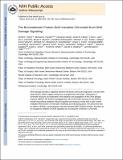The bromodomain protein Brd4 insulates chromatin from DNA damage signalling
Author(s)
Floyd, Scott R.; Pacold, Michael E.; Huang, Qiuying; Clarke, Scott M.; Rameseder, Jonathan; Lee, Michael J.; Blake, Emily J.; Fydrych, Anna; Ho, Richard; Del Rosario, Amanda M.; Root, David E.; Carpenter, Anne E.; Hahn, William C.; Sabatini, David M.; Chen, Clark C.; White, Forest M.; Bradner, James E.; Yaffe, Michael B.; Lam, Fred Chiu-Lai; Cannell, Ian Gordon; Bryson, Bryan D.; Greenberger, Benjamin Aaron; Chen, Grace; Maffa, Amanda D.; ... Show more Show less
DownloadYaffe_The bromodomain.pdf (3.453Mb)
PUBLISHER_POLICY
Publisher Policy
Article is made available in accordance with the publisher's policy and may be subject to US copyright law. Please refer to the publisher's site for terms of use.
Terms of use
Metadata
Show full item recordAbstract
DNA damage activates a signalling network that blocks cell-cycle progression, recruits DNA repair factors and/or triggers senescence or programmed cell death. Alterations in chromatin structure are implicated in the initiation and propagation of the DNA damage response. Here we further investigate the role of chromatin structure in the DNA damage response by monitoring ionizing-radiation-induced signalling and response events with a high-content multiplex RNA-mediated interference screen of chromatin-modifying and -interacting genes. We discover that an isoform of Brd4, a bromodomain and extra-terminal (BET) family member, functions as an endogenous inhibitor of DNA damage response signalling by recruiting the condensin II chromatin remodelling complex to acetylated histones through bromodomain interactions. Loss of this isoform results in relaxed chromatin structure, rapid cell-cycle checkpoint recovery and enhanced survival after irradiation, whereas functional gain of this isoform compacted chromatin, attenuated DNA damage response signalling and enhanced radiation-induced lethality. These data implicate Brd4, previously known for its role in transcriptional control, as an insulator of chromatin that can modulate the signalling response to DNA damage.
Date issued
2013-06Department
Whitaker College of Health Sciences and Technology; Massachusetts Institute of Technology. Computational and Systems Biology Program; Massachusetts Institute of Technology. Department of Biological Engineering; Massachusetts Institute of Technology. Department of Biology; Whitehead Institute for Biomedical Research; Koch Institute for Integrative Cancer Research at MITJournal
Nature
Publisher
Nature Publishing Group
Citation
Floyd, Scott R., Michael E. Pacold, Qiuying Huang, Scott M. Clarke, Fred C. Lam, Ian G. Cannell, Bryan D. Bryson, et al. “The Bromodomain Protein Brd4 Insulates Chromatin from DNA Damage Signalling.” Nature 498, no. 7453 (June 2, 2013): 246–250.
Version: Author's final manuscript
ISSN
0028-0836
1476-4687